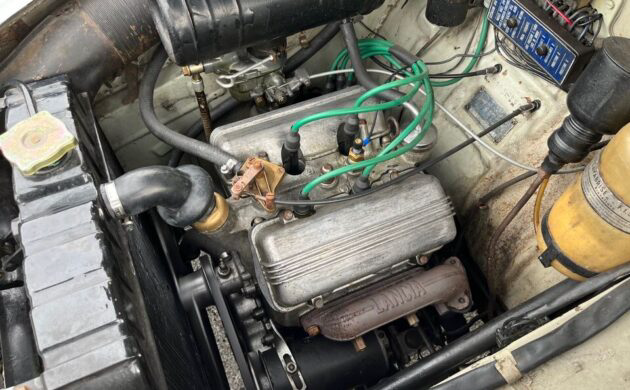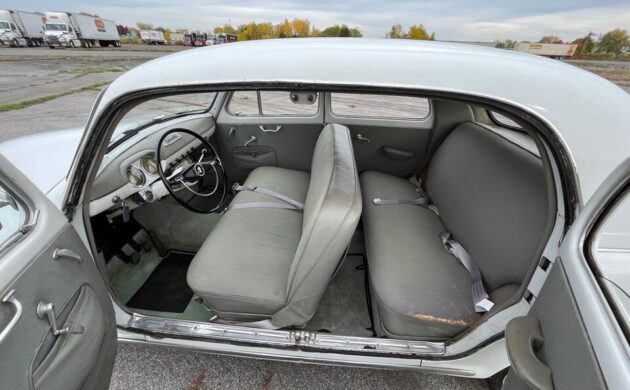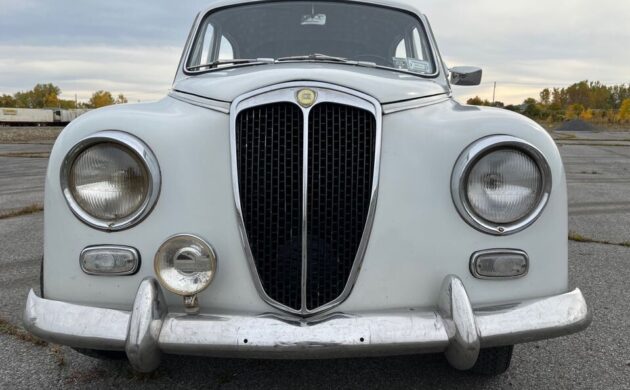We have met the character Vittorio Jano before, in this review of an Alfa 6C, and we are about to meet him again. Jano architected some of the most enduring engines in history. After he left Alfa in 1936, he joined Lancia. It turns out he was really interested in racing, thus his final resting spot career-wise was at Ferrari. But while at Lancia, he had a hand in creating this small Berlina meant to replace the aging Ardea and boost sales, called the Appia. The Appia looked a bit like an Aurelia that had gone through the wash on the “hot” setting, shrinking its dimensions. Here on facebook Marketplace is a 1957 Lancia Appia Series 2 with an asking price of $14,750. This car is located in Syracuse, New York. The seller says this car has just a couple of spots of rust, and it runs, drives, and shifts well after substantial mechanical work. We have Peter Rettig to thank for this bellissima tip!
While Lancia claims many interesting engineering feats and “firsts”, its engines stand out. The Appia utilizes a V4 displacing 1089 cc’s and making just over 40 bhp. Jano reworked Lancia’s existing engines – its V4 dated back to 1922 when it first showed up in the Lambda, a fabulous car – to come up with this offering, with only ten degrees of angle and small enough to duck under Italy’s 1.1-liter tax limit. This engine has benefited from a complete rebuild by an expert in Lancia mechanicals, detailed in the seller’s ad. While it’s a little guy, I can say from experience that these provide an incredibly entertaining drive. Be prepared to row the four-speed column-shift manual with enthusiasm: this car can go 80 mph.
Meanwhile, Jano was failing at the sales boost that Lancia was looking for. Enter Antonio Fessia, who refined the Appia at the outset of the production of the second series. The addition of a trunk lid, a longer wheelbase for more legroom, and other niceties still did not spur sales. But this little car doesn’t know it wasn’t loved back then: its suicide doors, lack of B pillar, wool seating surfaces, and general quirkiness brings buyers today who appreciate its Italian style.
The sinking feeling that Lancia was experiencing in the sales department didn’t abate until Lancia updated the Appia yet again, producing the Series 3. With a more conventional grille lacking the distinctive “shield” shape and a lower hood line, the Series 3 outsold both previous Appias combined. Collectors prefer the pure, early iterations of this car, however. This example, with its mechanical refurbishment and tidy appearance, is worth the price and should sell readily once the right Lancia aficionado comes along.




Thank you for sharing some of Lancia’s history. Such a wonderful and innovative car company with many world firsts such as the first production V6 engine. Such a charming little car that at first glance one would think it came from England. Personally I would love to own a Fulvia or a Zagato if I strike it rich.
It is true that Lancia was innovative. Sometimes Lancia was innovative in the way the French were innovative, which makes you say what the heck! Inboard brakes. A rear-mounted transaxle paired with a front-mounted engine, said transaxle containing the clutch and differential. Other stuff was less weird and more charming, like the louvers that descend on the radiator in cold weather or the adjustable suspension. But still. They are complicated little beasts.
A transaxle by definition includes the differential, and commonly the clutch as well (e.g., the Alfetta and 924/944 platforms), also not uncommon to package with inboard brakes (as with the Alfetta) to reduce unsprung weight since the transaxle itself is already unsprung, being mounted to the chassis.
I dispute the brilliant Lancia engineering trope as well. Often it is just unecessary complication. The famous narrow V engines never give enough bangs per buck, cost a lot to tune etc. If they were the answer to any significant question, they would have been widely copied. Very few bothered.
As you say, Jano was an Alfa rngineer and the transaxle came wiyh him from Alfa. He lost his job to Fessia because of politics in the takeover of Lancia by the Pesenti family. Jano moved to Ferrari, designed the Dino V6 and developed the 250 V12.
Not sure what you mean by complicated. Having fully restored a Appia 3rd Berlina and in process restoring an Appia Convertibile they are very straight forward and very well engineered. Yes, Aurelia’s are more complex, but not that exotic.
If one finds Appias too complex they need to find another hobby.
Congratulations on your restorations! Good for you. …. By “complicated” I mean that Lancias are less conventional than other cars, that solutions Lancia combined into models do not necessarily look like, say, an MGB. I grew up working on MG cars, so it is true that sometimes what I see on my Lancias puzzles me. I am not sure why it would be necessary to “find another hobby” just because one finds an Appia complex, which I didn’t actually say. I was making a comment to alfasud generally about Lancias overall. I have an Aurelia, and that is the car I was thinking of when I commented on the transaxle. I appreciate the challenge of figuring out cars I don’t know much about; it’s satisfying and one of the reasons I am engaged in this hobby. Generally, I think a good approach is to help others through the puzzles, rather than suggesting it would be better to give up.
I´ve had Alfasud Ti, Fulvia coupe and Fulvia Zagato. The Alfasud was a later car, maybe, but for me better in most ways than the Fulvias. The Zagato is an event, but that´s because of Zagato more than Lancia.
Fulvia 1.3 coupé is good value for money still, but some people say that the best Fulvia is the sedan, which is half price over the coupé.
First of all I agree that my favorite Fulvia is the sedan, have been in one all over Italy back in the day. The coupes are more of a sports car…
The Alfasud is a later car so the comparison is a bit weak. It’s like comparing my 2019 MB to my Appia Berlina, yeah I guess the Benz is a better car. And Alfasud’s were not known for quality…
…..alfasud sprint
Make mine a Stratos HF with the Dino V-6 engine please
I’d happily take this one, but those whitewalls gotta go!
Transaxle means better up to 50/50 weight distribution and more
traction. It’s the solution for a lightweight body with a good
engine. Or called driving dynamics.
Perfect car as most Lancia’s are. Il spirito Italiano
Perfect apart from the rust problem. I think Italy made cars from recycled toothpaste tubes back in the day.
Most old cars rusted but today WE have technology who
keeps oxidation on metals for ever off. And NO, its not
the cataphorese-zinc ‘submersion bath’. (Sorry my trans-
lator dont know technical descriptions)
The Appia didn’t have a transaxle, just a solid axle on leaf springs. The Aurelia, Flaminia did have a front engine with a rear transaxle and inboard brakes. The disk brake setup on those is pretty much the same as a Jag. The App is has drums.
The Appia is neat, but they are slow, the Flavia, Flaminia and Aurelia can be driven in modern traffic without issues, the Appia, not so much. Oh and parts are expensive.
This feels like a slightly more pedestrian version of the Aurelia, a car I have admired and lusted for. Unfortunate this Appia no longer has the original, matching-number engine, but the new engine was certainly thoroughly rebuilt.
Seems like an affordable way to get into Italian cars of the 50’s, and you’d be the only one on your block to own one!.
Yes, many Lancia folks refer to an Appia as a mini Aurelia…
The quirky door opening was called “ad armadio” (wardrobe style).
be very happy to own, drive’n tinker (still havent gotten a bent4 in the shop). But there’d still B that lust for the top Lancias (life long now), 3/4 of the way… A marker of sorts, still none rough enuff, yet restorabe (sweet spot for us ‘poor guys’). Those days gone w/auctions, net sales and the even deadlier when in combo.
I bought this car in 2006 from a person in Maryland who assured me it ran well. I don’t know when it came from Italy, but it was long before 2015, as the current seller claims. It arrived in San Francisco on a closed carrier, soaking wet, muddy and stinking, and every inch of the interior crawling with ants. The driver told me they hauled it out of a muddy field and it certainly looked that way. Absolutely my fault for not checking it out before I bought it. I opened it all up, removed everything I could, vacuumed out the ants, and put it in a warm garage for a few years to dry out.
Of course it was a total and complete basket case, nowhere near operational, and it sat in the garage for a long time before I took it to Lancia specialist Larry Buskirk in Novato. After an embarrassingly colossal outlay, it ran, but still needed a lot of work. The person who said Italian cars of that era were made of recycled toothpaste tubes had it right. But I was in love, and determined to get it going, which I did. I drove it about ten miles after Larry finished the work, and it shifted more pleasingly than any car I’d ever driven, so at least that was fun, but by then I just wanted it gone because it reminded me of how stupid I’d been. I guess the lesson is to try to keep one’s passions under control. I know I’m not the first car person to have egregiously overspent on a nonsensical stunt, but that’s someone else’s gain.
I hope it gets a good home. Maybe the people who’ve owned it since I did have put some work into it, but if not, it’s no spring chicken. I’d still like to find a good Appia one of these days.
Robert – bravo for that painfully honest history lesson. You are to be thanked for the truths you reveal, both about the car and the experience. We all have such cars — and perhaps wives — in our histories, and they are both hard to talk about, and life lessons we have learned.
Tom thank you for your kind words. Cars and people are boundless sources of both joy and grief. But as our parents used to say, “Watch where you step.” These days I’m more amused than angered by my own idiocy.